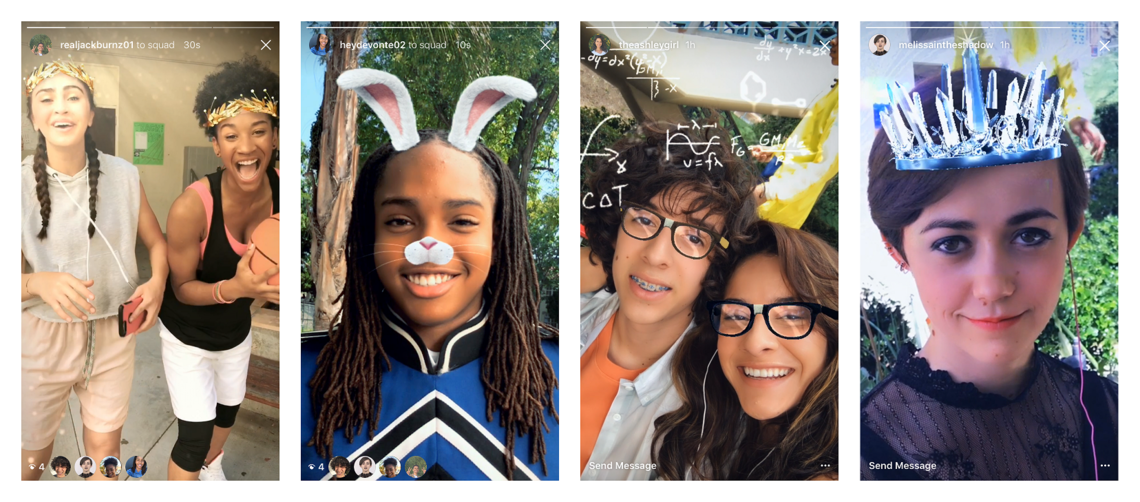Insight Memo analyzes various survey data to uncover consumer insights. This time, we invited members from Facebook Japan, which operates social networking services like "Facebook" and "Instagram," and held a roundtable discussion with researchers from DENTSU SOKEN INC. Media Innovation Research Department.
DENTSU SOKEN INC., which has been researching smartphone users' "visual communication" since 2015, recently announced the results of its "Survey on Visual Communication via SNS Among Young People." This roundtable aimed to gain a more multidimensional understanding of user trends and insights by discussing the survey findings with Facebook, the company that actually operates large-scale SNS platforms.
Facebook, the SNS operated by Facebook Inc., has 27 million monthly users in Japan, while Instagram has 16 million (both figures as of March 2017). Over 90% of access comes from smartphones, making SNS an indispensable part of Japanese daily life. The discussion aimed to clarify the impact of SNS penetration and the changes occurring within it.
The following findings were extracted from the "Survey on Visual Communication via SNS Among Young People." This time, we focus on "visual communication," which is becoming mainstream among young people. What insights can we draw from this?
The background for conducting this survey was the high affinity between SNS and the "experience domain." Shota Ogura of DENTSU SOKEN INC. explains the survey's purpose:
"The defining feature of SNS is the strong connection between the online and offline worlds. Users share their life experiences—such as events or travel—as 'content,' which is then shared and consumed within SNS relationships connected to the real world. In this sense, SNS is a service that has rapidly embraced the 'experience domain,' which has gained significant importance in recent marketing, as it is driven by 'value generated between people.'"
"Furthermore, the proliferation of smartphones and advancements in visual technologies like video have enhanced individuals' expressive and communication capabilities, expanding the potential of SNS within the experiential domain. We believed that deeply investigating these SNS usage characteristics could yield valuable insights for future marketing."
In an era where products alone don't sell, and where individuals' ability to disseminate information grows year by year, the existence of SNS—highly compatible with real-world experiences and events, i.e., the experiential domain—becomes increasingly crucial when considering marketing.
Regarding the focus on 'visual communication among younger demographics' within SNS, Akira Amano of DENTSU SOKEN INC. explains:
"As smartphones became the primary device for SNS use, more users became content creators. Driven by increased usage, particularly among younger women, sharing daily experiences through photos and videos has surpassed text-based posts. Our research uncovered unprecedented insights into the motivations of users who enjoy this 'visual communication'."
Yukiko Shimomura, who handles public relations at Facebook Japan, describes the shift toward visual communication as a global trend, not just in Japan.
"The proportion of communication using photos and videos is increasing globally. Younger generations, in particular, are leading the shift from text-based communication to visual communication," says Shimomura.
Against this backdrop, all social networking services are now enhancing their visual communication features. Facebook added a camera function to its smartphone app, incorporating numerous effects for photos and videos, such as "masks," "frames," and "filters." It has also added over 5,000 types of frames and stamps to the Messenger app.
Furthermore, services originally built around visual communication, like Snapchat and SNOW, are expanding their features daily. LINE's "LINE Camera" app, which allows free use of popular stickers, is also gaining attention.
Instagram, synonymous with visual communication, focused on enhancing its Instagram Stories feature launched last August. Alongside location and hashtag stickers, it added the highly requested "face filters."
Eri Mishima, an Instagram Community Manager who primarily interacts with users in the Asia region, explains that the key reason Instagram was quickly embraced by young people in Japan lies in the trend toward visual communication.
"Instagram was originally a platform centered around visuals. We take pride in having led the shift from text to visuals. Over the past five years, communication on social media has become more visual than ever, demanding formats that are easy and quick to share. From last year to this year, we added features like Instagram Stories and live streaming, where photos and videos disappear within 24 hours. These too are rapidly gaining acceptance among young users," says Mishima.
The reassurance of "disappearing" and "not remaining" accelerates communication

Instagram Stories, which automatically disappear after a set time. It's fair to say this feature was born from today's SNS culture.
Mr. Amano states that the recent characteristics of video services used by young smartphone users on SNS and their information behavior there can be summarized under the keyword "ES-M-L".

First, the current trend gaining attention is "Ephemeral" (meaning fleeting or lasting only a day). This refers to photos and videos in formats that disappear after a set time, exemplified by Snapchat and the aforementioned Instagram Stories.
Instagram Stories usage has continued to grow steadily, reaching over 200 million daily users worldwide by April 2017. Mr. Mishima, who listens daily to requests from the user community, speaks about the demand for ephemeral content:
"The background for implementing Instagram Stories was the community's need to 'share everyday moments more casually.'"
"Instagram has this image as a place to share important memories or daily highlights, right? Previously, since every post stayed on your profile, people inevitably worried about how it looked or what they shared, making it hard to post casually. But actually, a lot happens in the 'gaps' between those highlights. Stories made it easy to share those ordinary, everyday moments too."
When these "casual everyday moments" are posted, you can feel what the poster is doing in real time and discover new sides to them. This seems to be another reason for its popularity, as it deepens the relationship with followers in a different way than before. Mr. Mishima gave the following example:
"Someone who usually posts photogenic landscapes on Instagram turns out to be a dad of two, sharing lots of photos playing with his kids on Stories. You get to know their personality, and it creates a new kind of closeness, right? For the poster, I think it's supported as a feature that lets them show a different side of themselves. Even celebrities and influencers sometimes feel comfortable sharing fleeting moments of their private lives on Stories, knowing they'll disappear automatically."
On the other hand, Amano, who has conducted various surveys among younger demographics, believes the demand for ephemeral video services stems from a "fear of permanence" unique to the smartphone-native generation.
"The internet's strength has always been its ability to store all kinds of information and provide open access to it. But recently, people are starting to recognize the downsides of things 'staying around,' and the value of things 'not staying around' is being discussed. Smartphone-native generations are especially sensitive to the 'risk of their photos remaining online forever.' That's precisely why services with disappearing features are hitting big, isn't it?"

Mr. Ogura and Mr. Amano of DENTSU SOKEN INC.
From "Photo-Perfect" to "Video-Perfect": The Shift in Social Media Trends
From "enhancing" for photos to "livening up" for videos

Instagram's Face Filters. Fun filters for editing both still images and videos are in high demand worldwide.
A key perspective for understanding the information behavior of smartphone users, especially female users, is "Moru" (image/video editing). Research revealed that teenage girls use an average of three photo editing apps per post.
Amano posits that the act of "Moru" represents a kind of "tradition" passed down in Japan. He analyzes the insights of users who master editing apps as follows:
"Even before SNS, there was a culture seeking cute 'enhancement'—like editing photos with purikura before sharing. Recently, however, communication increasingly centers on video, amplifying the desire to 'liven up the moment.' Video can convey the 'energy of the moment.'"
"Video filters are particularly effective in such situations. Not only do they allow for 'enhancement,' but they also provide a significant element of 'livening things up' by letting users shed inhibitions and present a non-authentic version of themselves. Interesting character masks are constantly expanding, with brands and publishers increasingly sponsoring them. Users find their everyday communication spaces enriched by using these. We're seeing more examples of this new type of 'advertising that gets used.'"
To provide more engaging ways to play, Facebook and Instagram are also integrating various effects and sticker features into their apps.
"Camera effects are one area we want to focus on at Facebook. For example, we're preparing a service that uses AR (augmented reality) image filters to create interactive experiences. We want to build a platform where everyone can express their creativity," said Shimomura.
"We recently added face filters to Instagram Stories. This was a highly requested feature from users. We designed them to be enjoyable not only for selfies but also when hanging out with friends," (Mishima)

Mr. Mishima and Mr. Shimomura of Facebook Japan
The main battlefield for live streaming is shifting from video streaming sites to social media
The third keyword is "Live" (live streaming on SNS). Traditionally, live streaming was centered on dedicated video streaming sites, but now a rapid "shift to SNS" is underway.
According to Facebook's research, as of April 2017, live videos accounted for 20% of all videos published on Facebook. Viewing time for live videos also increased fourfold year-on-year, clearly demonstrating rising demand on social media.
Regarding live video streaming on Facebook, Mr. Shimomura notes, "It's often used to 'share the moment with everyone'—for example, students on school trips or tourists broadcasting scenes from their destinations."
"Companies are also actively utilizing it, such as live streaming seminars, events, and sports matches on Facebook. In May 2017, 'Live Chat With Friends' was introduced, allowing users to engage in private chats with specific friends while watching a live stream, further enhancing real-time conversation through live video," said Shimomura.
Meanwhile, demand is also high for ephemeral live streaming that isn't archived. "Facebook Stories" tends to feature more personal and casual content. Instagram also introduced live streaming within Stories in January.
"Live streaming on Stories is especially popular among younger generations. We often see people streaming when they're alone and feeling a bit bored, or when they're hanging out with friends or eating together," said Mr. Mishima.
Regarding the benefits of SNS live streaming, this survey gathered user feedback such as: "I don't want to save it long-term, but I want to share the memory," and "Editing and posting videos lets me connect with many people and express myself." The low barrier to posting, the ease of self-expression, and the realization of SNS-style communication may be driving the shift of live streaming to SNS platforms.
Mr. Amano pointed out a common theme among ES-M-L: "In an information environment saturated with content, the 'one-time nature' of communication paradoxically enhances its value. I believe the smartphone-native generation is more conscious about how much they can enrich the intensity of that single moment."
Joining the roundtable discussion via emergency group video call, Facebook Japan's Takeshi Oshima summarized as follows:
"Regardless of which ES-M-L you look at, there's an aspect where they're used to 'liven up the moment' or for 'here-and-now' communication, right? Looking at this survey's results, it was interesting to see that many users enjoy the process itself of 'taking and enhancing photos and videos while hanging out with friends.'"
"While photos and videos serve as self-expression and documentation, there also seems to be an element where visual communication on SNS is perceived as 'play.' And isn't this very 'play' the practice that pioneers yet-unseen forms of communication?"

Mr. Oshima, Facebook Japan
※Next time, we'll discuss new search methods among the smartphone native generation and the value of SNS from a marketing perspective!

























